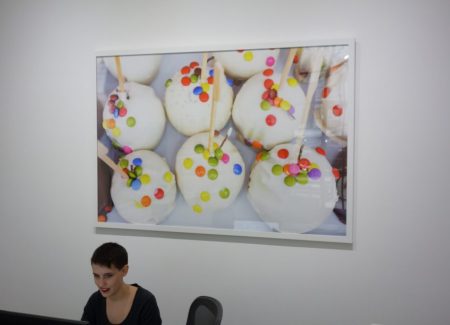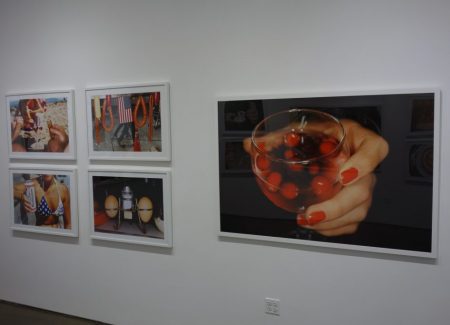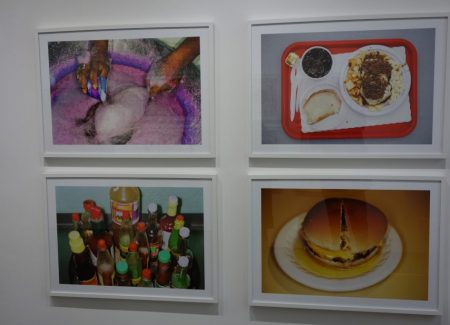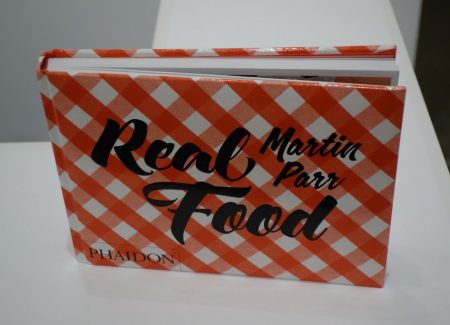JTF (just the facts): A total of 19 color photographs, framed in white and unmatted, and hung against white walls in the single room gallery space. All of the works are pigment prints, made between 1995 and 2016. The prints are shown in two sizes: 20×30 (in editions of 10) and 40×60 (in editions of 5). There are 16 prints in the smaller size and 3 prints in the larger size on display. A monograph of this body of work was recently published by Phaidon Press (here). (Installation shots below.)
Comments/Context: In the same way that comedic actors and actresses in movies seem to get overlooked every awards season in favor of their more dramatic counterparts, contemporary photographers that use humor in their work tend to be undervalued and misunderstood by those who take the medium “seriously”. A recent example of this look-the-other-way behavior can be found in how we react to the pictures of the British photographer Martin Parr.
Parr is a prolific shooter and photobook maker, churning out new projects with a consistent rapidity few can match. His eye for photographic color, interwoven composition, and unlikely subject matter is particularly original, but that signature aesthetic is generally lost in the wake of his cleverly wry viewpoint – whatever he might be looking at, if we only pay attention for a fleeting moment, it’s easy to wonder whether he’s joking (or potentially mocking). Even the most jaded of us can see the fun he is having at seaside resorts, art fairs, tourist destinations, and quirky stops the world over, and that leads us to question whether we are supposed take these images entirely seriously. And all too often, that chuckling and back slapping fails to give Parr the credit he deserves for the deceptively sophisticated photographic intelligence he so routinely displays.
Real Food brings together two decades of Parr’s food imagery, and it’s hard not delight in its expansive range of delicacies and grotesqueries. Food photography is of course nothing new, and Parr’s contributions to the genre are worthy additions to the canon, perhaps in spite of the fact that they are so bright and entertaining. If we want to be comprehensive, we can go all the way back to William Henry Fox Talbot and his 19th century still lifes of fruit baskets as the official starting point for food photography, and this echoing of the motifs of painting was the dominant food aesthetic until the arrival of commercial and advertising photography in the 1920s. From there we can trace a direct line from the surreal garishness of Outerbridge to the stylized perfection of Penn, and forward to the slick farm-to-table crispness of today’s magazine glossies.
The unexpected kink in the photographic food road came in the early 1970s, when Stephen Shore decided to document what he was having for breakfast. His top-down diner shots consciously avoided the cleaned-up look of the commercial aesthetic and brought us back to a sense of the unadorned real – this is what American eating was really like, from buttered toast and stacks of pancakes to juicy steaks and baked potatoes in tinfoil. These conceptually innovative pictures (in color, no less) spawned a separate line of more in situ food photography that runs through Eggleston, Tillmans, and onto every joker with a smartphone and an Instagram account who feels compelled to share what’s on today’s menu.
Parr’s food photographs seem to draw equally from these two competing aesthetics, reacting to their aesthetic codes and forging something new. His images revel in the outlandish color and up close detail familiar from a commercial setting, while always staying grounded in the human touch of an ice cream cone in a hand or the imperfections of street fairs, aging displays, and hand scrawled food stall signs. Parr’s foods are also resolutely multicultural, not so much in the anthropological sense, but more as a celebration of the joys of human diversity and eccentricity. He’s traveled the world over capturing countless specialties and regional favorites, in which his playful eye has found plenty of hints of unintended comedy – what some of us find as entirely delicious others might see as thoroughly revolting, and that interplay of food weirdness gives his pictures yet another layer of muted dissonance.
These images turn on two sets of artistic decisions – what he’s chosen to show us and then how he’s photographed those particular subjects. His eye wanders from an impossibly dense cluster of Mexican hot sauce bottles and a dainty boiled egg holder in France to a butter-drenched cheeseburger from Milwaukee and an extra long pair of sausages from Vienna accompanied by sauerkraut and obvious female cleavage, seemingly always on the lookout for symbolic resonance, national pride, and fortuitous juxtaposition. His selections are alternately happy (a powdered sugar smiley face on a carnival doughnut), quizzical (an overly small Alice in Wonderland teacup with a single raspberry floating in it), patriotic (the king of beers paired with a stars and stripes bikini), and downright puzzling (the “garbage plate” from Rochester, NY), his choices demanding reaction and engagement. Bold, exuberant color is often Parr’s friend and ally, giving extra punch to a cluster of red cherries in a cocktail glass, the magical swirl of pink and purple in a cotton candy maker, and a bowl of red jelly being sampled by a bee. And even when Parr overtly uses bright flash to fill his frames, his photographs are always more than just brash off-the-cuff snapshots – the simple aesthetics camouflage his rich sense for isolation and close-in layering.
In Parr’s food, we discover again and again the wonderful absurdity of the world around us. His visual cheekiness highlights the edge of ridiculousness underneath our cultural touchstones, and those insights are delivered with the visual equivalent of good natured teasing. That we sometimes fail to acknowledge the brilliance that is required to make such images is our own fault – we’re often too busy having a good time with Parr’s photography to recognize just how smart and accomplished it really is.
Collector’s POV: The works in this show are priced as follows. The 20×30 prints are £4000 each, while the 40×60 prints are £8500 each. Parr’s prints are intermittently available in the secondary markets, with recent prices ranging between roughly $1000 and $12000.











So insightful!! Thanks!